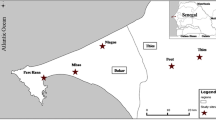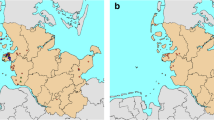Abstract
In UAE, camel Physocephalus dromedarii was diagnosed for the first time in 2011 in dromedaries from a farm that previously had imported animals from foreign countries. The large scarab beetle, Scarabaeus cristatus, was found to be the major intermediate host for this parasite in Dubai. A total of 638 specimens of S. cristatus were collected and examined for the presence of third-stage larvae of nematode larvae at two sites in the Dubai Emirate (Emirates Industry for Camel Milk and Products and horse endurance training track) within a distance of 15 km. Third-stage larvae of P. dromedarii were detected in 94 and 97 % of beetles collected from the territory of the camel milk farm and the endurance training track, respectively. In addition to third-stage larvae, 264 beetles contained second-stage larvae. Only four beetles were infected with other than P. dromedarii larvae. The average larval burden in beetles from camel milk farm was significantly higher compared to those in beetles collected from the other site (1538 vs. 697). Comparison of larval burdens in juvenile and adult beetles collected at the camel milk farm showed a significantly higher intensity in adult specimens (501 vs. 1734) while in beetles found on the horse endurance track, larval burdens were comparable (548 vs. 858). The results suggest that S. cristatus become infected at the camel milk farm, and in search for other sources of food, they fly to places where they were found feeding on feces of other animals.
Similar content being viewed by others
Notes
In previous examination, artificial gastric juice was used to digest the body content of the beetles. The pepsin solution, however, destroyed the delicate second-stage larvae that are present in some of the beetles, and treatment of the cut beetle in warm water on a magnet stirrer was sufficient to remove both types of larvae. Second-stage larvae were not counted in this study. Their presence as evidence of a fresh infection was just noticed in the excel file. These larvae were of variable size measuring 400 to 1200 μm and had a rounded tail tip.
References
Abdul-Salam JM, Farah MA (1988) Seasonal fluctuations of gastrointestinal helminths of camels in Kuwait. Vet Parasitol 28:93–102
Alicata JE (1935) Early development stages of nematodes occurring in swine. Technical Bulletin No 489. US Department of Agriculture, Washington, D.C. 1–95
Altaif KI (1974) Helminths in camels in Iraq. Trop Animal Health Prod 6:5–57
Anvari-Tafti M, Sazmand A, Hekmatimoghaddam S, Moobedi (2013) Gastrointestinal helminthes of camels (Camelus dromedarius) in Center of Iran. Trop Biomed 30:56–61
Chauve M, Hamza-Cherif R, Marfoua K (1990) Parasitism chez le dromedaire (Camelus dromedarius) en Algérie: enquetes dans 4 wilayats (Adar-Bechar-Laghouat-Ghardaia). Maghreb Vét 5(35–36):38–39
Gibbons LM, Nicholls PK, Bailey T, Samour J (2004) Paraspiralatussakeri n.g., n.sp. (Nematoda: Spiruroidea, Spirocercidae) from a saker falcon, Falco cherrug in Saudi Arabia and the first report of larvae from the subcutaneous tissues of houbara bustards, Chlamydotis undulata macqueeni in Pakistan. J Helminthol 78:33–40
Halffter G, Halffter V, Favila ME (2011) Food relocation and nesting behavior in Scarabaeus and Kheper (Coleoptera: Scarabaeinae). Acta Zool Mexicana 27:305–324
Kazim SI, Ramamurthy VV (2004) Coleoptera (Insecta) fauna from the Indian Thar desert, Rajasthan. Zoos’ Print J 19:1447–1448
Mirzayans A, Halim R (1980) Parasitic infection of Camelus dromedarius from Iran. Bull Soc Exot Fil 73:442–445
Mushkambarova MG, Dobrynin MI (1972) Materials on physocephalosis of the one humped camel in Turkmenistan (in Russian). Izv Akad Nauk Turkm SSR Ser Biol 4:62–67
Ridsdill-Smith J, Simmons LW (2009) Dung beetles. In: Resh VH, Carde RT (eds) Encyclopedia of insects, 2nd edn. Academic, London
Roberman SL (1939) On the biology of the pathogen of swine invasive gastritis—Physocephalus sexalatus. Pap Kirgistan Agric Inst 1:1–13
Sanchez PF (2007) Predation of Scarabaeus cristatus F. (Coleoptera, Scarabaeidae) by jerboas (Jaculus sp.: Rodentia, Dipodidae) in a Saharan sand dune ecosystem. Zool Baetica 18:69–72
Schuster RK, Thomas K, Sivakumar S, O’Donovan D (2009) The parasite fauna of stray domestic cats (Felis catus) in Dubai, United Arab Emirates. Parasitol Res 105:125–134
Schuster RK, Wibbelt G, Kinne J (2013) A re-description of Physocephalus dromedarii stat. nov. (Nematoda: Spirocercidae), an abomasal nematode of dromedaries (Camelus dromedarius). J Helminthol 88:499–505
Schuster RK, Wibbelt G, Kinne J (2014) On the life cycle and morphology of development stages of Paraspiralatus sakeri Gibbons et al., 2004 (Nematoda: Spiroidea, Spirocercidae), a heteroxenic stomach parasite of falcons. Parasitol Res 113:2047–2051
Schuster RK, Wibbelt G, Sivakumar S, Reiczigel J (2015) Light and scanning electron microscopical examination of the third stage larva of Physocephalus dromedarii (Nematoda: Spirocercidae)—an abomasal nematode of the one humped camel (Camelus dromedarius). Parasitol Res (in press)
Sergeant, ESG (2015) Epitools epidemiological calculators. AusVet Animal Health Services and Australian Biosecurity Cooperative Research Centre for Emerging Infectious Disease. Accessed on 30 July 2015 at http://epitools.ausvet.com.au/content.php?page=home
Seurat LG (1912) Sur la présence an Algérie du Spiroptera sexalata Molin chez le Dromadaire et chez l’ane. C R Seances Soc Biol Fil 64:174–176
Sidek J, Pokorny S (2008) Illustrated key to Palearctic Scarabaeus Linné (Scarabaeidae). Animma X(27):1–30
Verdu JR, Arellano L, Numa C (2006) Thermoregulation in endothermic dung beetles (Coleoptera: Scarabeidae): effect of body size and ecophysiological constrains in flight. J Insect Physiol 52:854–860
Author information
Authors and Affiliations
Corresponding author
Rights and permissions
About this article
Cite this article
Schuster, R.K., Sivakumar, S., Ismail, A.A. et al. Scarabaeus cristatus (Coleoptera: Scarabaeidae) as intermediate host of Physocephalus dromedarii (Nematoda: Spirocercidae)—a contribution to the epidemiology of camel physocephalidosis. Parasitol Res 115, 1161–1166 (2016). https://doi.org/10.1007/s00436-015-4850-z
Received:
Accepted:
Published:
Issue Date:
DOI: https://doi.org/10.1007/s00436-015-4850-z




